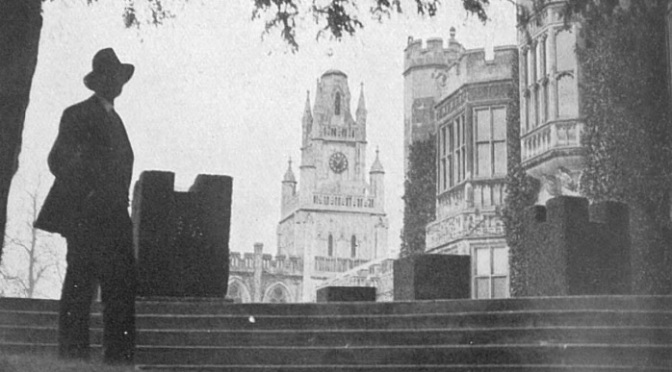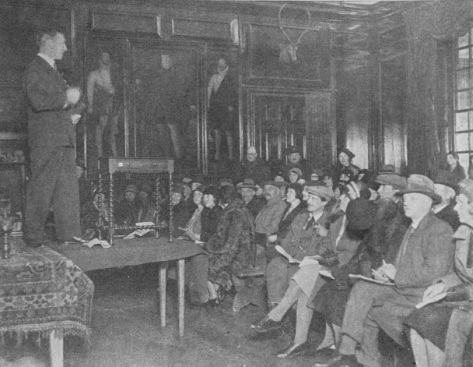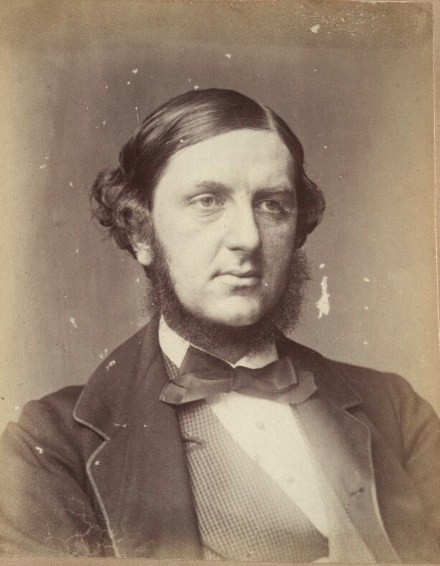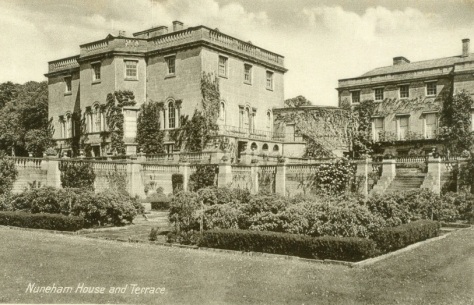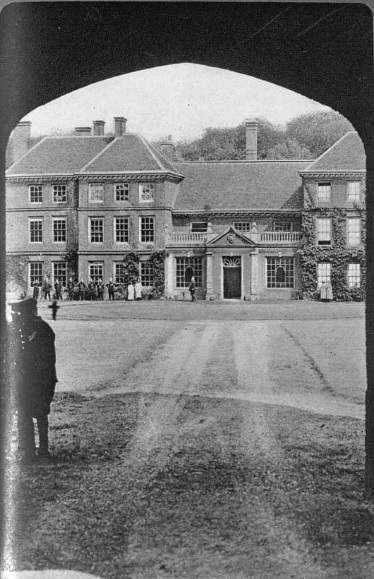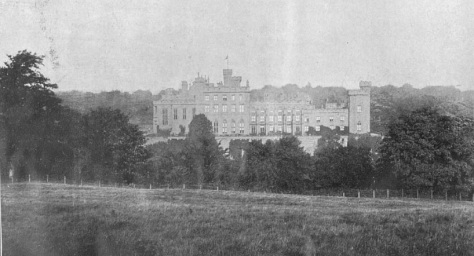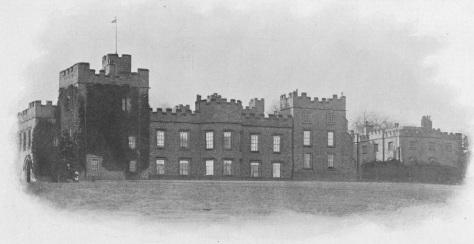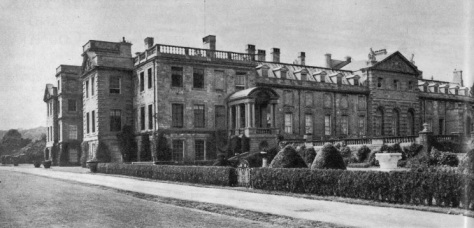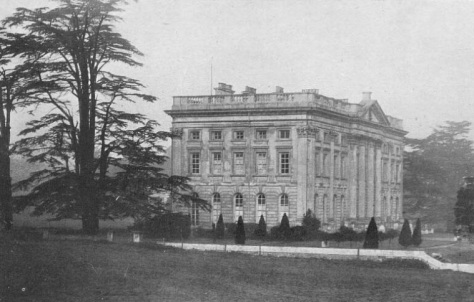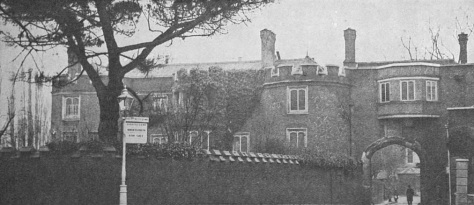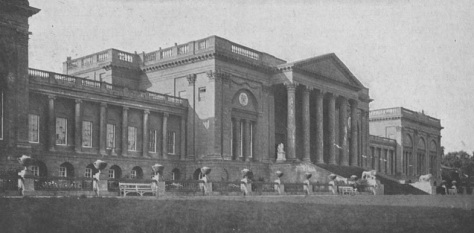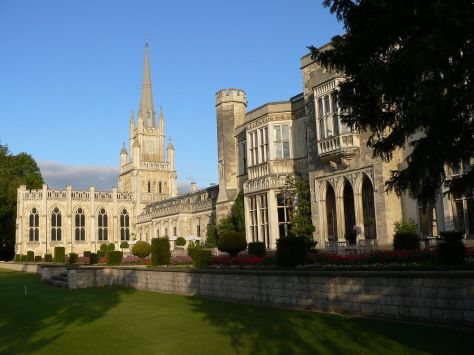On the eve of ‘The Destruction of the Country House’ exhibition, an aspiring writer traced the social and economic reasons for the decline of the English country house and described the dangers that threatened those remaining

In October 1974, a landmark exhibition opened at the Victoria and Albert Museum in London. The Destruction of the Country House had been conceived following a conversation between the museum’s director, Roy Strong, and John Cornforth, the architectural historian, then compiling his important report on the ‘present’ state of our country houses, the first since the 1950 Gowers Report. The exhibition included a Hall of Destruction decorated with falling columns and illustrations of some of the hundreds of country houses demolished since 1875.
By the end of the exhibition, the total number of houses was found to be over 1,600. Forty years later, Matthew Beckett, ‘the statistician of loss’, found that between 1880 and 2014, the number of houses demolished was 1,921. A record of these can be found on his Lost Heritage website, and the number keeps increasing as we find more candidates – vanished, forgotten and then remembered again!
The exhibition was curated by Roy Strong, John Harris, then working at the Royal Institute of British Architects, Marcus Binney, soon to become Architectural Editor of Country Life Magazine, and Peter Thornton, from the V&A’s Department of Furniture and Woodwork. The exhibition did more than anything to bring the plight of our ‘suffering’ country houses to the attention of the public.

Days before the opening of The Destruction of the Country House, an article appeared in the Illustrated London News, written by John Martin Robinson, a 26-year-old Lancastrian who had just been awarded a doctoral degree for work on the architect Samuel Wyatt. By the end of the year, he was working for Greater London Council’s Historic Buildings Division, contributing to the Survey of London, inspecting buildings in Westminster and revising the Statutory Lists of Historic Buildings across the city. In time, we would know Robinson as an Architectural Writer for Country Life, as well as being the author of almost thirty books.
In 1974, John Martin Robinson was an unknown entity, but mature enough to write The Future of England’s Country Houses for a magazine that had been published since 1842. Unfortunately, like many of the country houses featured, the magazine eventually disappeared. However, forty-four years later, Robinson’s narrative still provides a definitive account as to how England’s country houses had got into such a perilous situation.
“No country can rival England in the number and beauty of its country houses in their setting of gardens, avenues and parklands. They are an association of beauty, art and nature achieved through centuries of effort, which has seldom, if ever, been equalled in the history of civilisation. The English country house is the greatest contribution made by England to the visual arts: thus, the Gowers Report on ‘Houses of Outstanding Historic and Architectural Interest’ summed up the object of its investigations in 1950. Yet despite their unquestionable artistic importance the survival of these houses has been increasingly jeopardised in this century and many have been destroyed.
“With hindsight the rumblings of the avalanche can already be discerned behind the apparent calm and opulence of the Edwardian heyday of the country house, threatening the tranquil world of tea under the cedar trees and white-gloved footmen festooning smilax around the dining-room candelabra.”

“From 1870 onwards, English agriculture faced an increasingly serious crisis and its economic viability was destroyed by large imports of cheap grain from North America. As a result, land ceased to be profitable and the economic base of the country house was undermined. The effects were not immediately apparent because the overall financial power of the country’s trade and industry helped subsidise country house owners, but that was a situation that could not last forever.
“The huge staffs of Edwardian houses were partly a response to the rural unemployment caused by agricultural decline. In many areas domestic service was the only means of providing a livelihood for the inhabitants of whole villages. One result of the agricultural slump was disastrous, and that was the amendment of the settled land law in 1882, which enabled landowners to sell entailed heirlooms, particularly works of art, to meet their debts and day-to-day expenses. This opened the floodgates, and the systematic disposal of the fabulous collections assembled here between 1610 and 1850 has gone on ever since.”

“Estate duty was first introduced in 1897 and greatly increased in Lloyd George’s 1909 budget. This was followed quickly by the First World War in which it was common for two or three heirs to be killed one after the other, thus incurring multiple death duties. Then in the period between the wars came drastic increases in the rate of income tax which bore more heavily on landowners than on any other section of the community.
“The destructive effect of increased taxation upon the upkeep of country houses is well known. Another equally powerful but less widely recognised factor has been the steady encroachment of industry and urban development in certain areas, and it is those areas which have seen the worst losses of country houses – particularly South Lancashire, parts of Durham, Nottinghamshire, Staffordshire and outer London. South Lancashire has sustained the worse losses of all and today only two country houses are still lived in. Six are museums, over 50 have been demolished and the remainder lie derelict or have been converted into institutions.”

“The first two important English houses to go, heralds of doom, were Giacomo Leoni’s Bold Hall in Lancashire in 1900 and (Sir Charles) Barry’s Trentham in Staffordshire in 1910. In both cases industrial development was immediately responsible for the abandonment of the house. At Trentham the river had become so polluted with sewage from Stoke-on-Trent as to render that palatial seat no longer pleasantly habitable. In the case of Bold Hall, the coal mines crept up to the park walls and the owner finally sold out to the colliery company which demolished the house, thus contributing to an ironic pattern of development whereby the lucrative mineral, which had paid for so many fine houses, now destroyed them.”

“The crash occurred in the 1920s. In 1922 Stowe was sold up, and though the house was saved from demolition for use as a school the interior was largely dismantled, and the surroundings littered with gymnasiums, laboratories and all sorts of necessary new buildings, to the permanent spoliation of the gardens, the finest in England. Then house after house was demolished. In 1922 the worst loss was Cassiobury Park near Watford, where a Wyatt exterior concealed splendid seventeenth-century state rooms. In 1925 Leoni’s finest English house, Lathom House in Lancashire, was razed to the ground. In 1929 occurred the most regrettable vandalism of all, the wanton smashing of domed Nuthall Temple in Nottinghamshire, which contained superb rococo plasterwork. And so, the melancholy story continued until the eve of the Second World War.”




“However, the horizon was not one of unrelieved gloom. New country houses continued to be built, often on a considerable scale, particularly such late works of Sir Edwin Lutyens as Gledstone Hall, Castle Drogo and Middleton Park. The latter was completed only in 1938, and had 12 principal bathrooms including Lady Jersey’s, which was lined in pink onyx and white marble with a vaulted ceiling. A casual glance through the pages of Burke’s ‘Landed Gentry’ shows that ‘new’ families continued to be recruited throughout the period. They bought estates and either built their own houses or brought new life to old ones. Those who restored old houses often assembled in them fine art collections and laid out gardens on an almost eighteenth-century scale. Three of the most notable achievements of this type now belonging to the National Trust: Buscot Park and Upton House near Oxford, and Anglesey Abbey near Cambridge.
“This period also saw the beginning of a constructive attempt to save the country house from ruin. In 1924 the National Trust first pressed for legislation to grant tax concessions to the owners of country houses. This was unsuccessful, but in 1934 Parliament passed a Bill enabling the Trust to accept historic houses. The first house received by the Trust, Blickling in Norfolk, was bequeathed in 1940 by the Marquess of Lothian. It was followed in the same year by Wallington in Northumberland, and today the Trust owns and maintains some 150 great houses.”

“During the Second World War houses were used as hospitals, schools and army barracks. The eventual result of this was, in many cases disastrous. As readers of ‘Brideshead Revisited’ will know the Army was not an appreciative tenant. A typical example is Egginton Hall in Derbyshire where, when the Army relinquished the house in 1945, all the taps were left running. The interior was irreparably damaged by water and the house was subsequently demolished. Schools were reckoned to be more civilised occupants, although while Castle Howard was in use as a school half of it was gutted by fire.”

“At the beginning of the war the Government refused to give guidance and help to private owners over the storage and protection of art collections. As a result, a great deal of unnecessary damage was caused. The Duke of Bedford relates how, on inheriting Woburn, he found the famous Sèvres dinner service lying loose in the straw in the stables, while French eighteenth-century chairs were piled up in heaps with kitchen table legs stuck through the seats.”
The subject of wartime requisitioning was one that John Martin Robinson would return to. His book, The Country House at War was published in 1989. Twenty-five years later, it was followed with the weightier Requisitioned: The British Country House in the Second World War.
“In 1945 the country house presented a huge, seemingly insoluble problem. No general maintenance had been done for at least six years, and many garden buildings and subsidiary structures had not been repaired since before the First World War because owners had had no money to spend on such ‘inessentials’. In many cases there seemed no alternative to demolition and over the next ten years hundreds were pulled down or truncated, as at Woburn, where half the house was demolished because of dry rot. The losses in this period were quantitively much greater than in the 1920s and 30s, though it could be argued that individually the houses destroyed were not of such great importance. The one absolutely irreparable loss was Coleshill, a statement of the utmost value to English architecture. It was gutted by fire in 1952. The Government declined to serve a preservation order on the shell, which as a result was demolished.”

“By the early 1950s it seemed as if the end had come for the country house, but there was in fact a remarkable recovery. This was largely due to the efforts of individual owners and also the post-war Labour Government. In 1945 the Minister for Housing and Local Government was empowered to make lists of buildings of special architectural and historic interest which were to be legally protected from demolition or unsympathetic alteration. Although slow in compilation (only 120 houses out of a target of 1,450 were listed in the first five years) and full of omissions and inconsistencies, they were better than nothing, and have developed in the succeeding years to become the foundation of all preservation work in this country. Then, at the invitation of Stafford Cripps, Chancellor of the Exchequer, a committee was set up to investigate the possibility of making grants and tax concessions to the owners of outstanding historic houses. In 1950 this committee produced the Gowers Report, as a result of which the Historic Buildings Council was established with the power to make annual grants for the restoration of great buildings.
“At the same time there was a dramatic revival in English agriculture. Landowners have reorganised their estates much more efficiently, and together with Government subsidies this has led to a doubling of the output of English farming and the restoration of its economic viability. Large-scale opening to the public, which started with Longleat in 1949, also provides funds for the upkeep of houses. This has given them a completely new raison d’etre, as well as presenting owners with additional incentive to maintain and improve their houses. As a result, many of the greatest country houses have been splendidly restored since 1960, and Chatsworth, Wilton, Holkham, Ragley and Althorp have never been so well cared for or looked so magnificent as they do today.”
John Martin Robinson’s use of the Duke of Devonshire’s Chatsworth House was a good example. The property had been ‘closed-up’ for many years but is now regarded as one of the country’s most popular visitor attractions. The other houses remain open to the public, in the case of Althorp in Northamptonshire, its popularity reached unprecedented heights for being the home and final resting place of Lady Diana Spencer, later Princess of Wales.



“A year ago, this article could have finished on that happy note, but now there are new dangers. The possibility of increased taxation, together with general economic recession, threatens the precarious finances of the owners of great houses. If a wealth tax were to be imposed upon such houses and their contents it would lead to certain ruin. Already there have been disquieting events. For example, Heveningham Hall in Suffolk had to be sold as a result of capital gains tax in 1969 and although bought by the Government most of its contents were dispersed and it stands today empty and without a use, a sad place to visit.”
The Wealth Tax didn’t materialise. Denis Healey, the Labour chancellor misquoted for saying “squeeze the rich until the pips squeak” came closest in his 1974 election pledge but was forced to backtrack. However, the possibility remains a distant threat as is the recurring menace of a Mansion Tax, a common name for an annual property tax on high value homes. There was a happy end for Heveningham Hall, after all. The halls and grounds were bought in 1994 by Jon Hunt and his wife to use as a family home. Extensive work has been carried out to restore the house and the Capability Brown grounds.


“The great increase in the monetary value of works of art is also, ironically, a threat. Not only are owners tempted to sell, as in the case of the Longford Castle Velasquez, but the increased monetary value of country house collections makes them a great security problem, as was highlighted by the recent spectacular theft of pictures from Russborough in Ireland. These treasures, however, form the greatest portion of the works of art in this country and far surpass in both quantity and quality the contents of our provincial museums. As well as the furniture and portraits which obviously form a unity with the architecture, about 100 great English houses contain important collections of European works of art formed between the seventeenth and mid nineteenth centuries, which as collections are of the greatest and aesthetic importance. England is the only country in the world where such historic collections survive on such a scale, and it would be tragic if they were to be dispersed.”
When John Martin Robinson referred to the theft of pictures (by the IRA) from Russborough House in County Wicklow, he wasn’t to know that they would be recovered, but stolen a further three times.
He continued:
“Another threat is to the landscaped parks in which these houses are situated. Unlike historic buildings, they enjoy no statutory protection despite the fact that they form some of the greatest works of art ever produced in this country. Those at Petworth and Chillington, designed by Capability Brown, as well as Port Elliot by Repton, are threatened by motorways. At Audley End the local council wish to place a sewage works in the middle of Capability Brown’s landscape, and many other eighteenth-century parks are also menaced by incongruous developments.
“It is essential therefore that the machinery of Statutory protection be expanded to cover the parks, gardens and the essential contents of historic houses. At the same time the system of grants should be extended to pay for such works as the renewal of the planting in eighteenth-century parks and the proper maintenance of the pictures and furniture in all privately-owned houses regularly open to the public. In 1950 the Gowers Report recommended that all the repair and maintenance costs of historic houses and their contents should be subject to tax relief. It was also recommended that landowners should be able to set aside part of their estates to produce a tax-free income for the support of the house in perpetuity.
“These recommendations were not adopted at the time, but their implementation is even more urgent now, and it is to be hoped that the Government will at least introduce effective legislation to protect country houses, their contents and collections, their parks and gardens from ruin. It would be tragic if despite the hard work of the last 18 years, the cultural achievement of five centuries were still to be needlessly sacrificed.”
And so he ended. Nine years after Robinson wrote about parks and gardens, the ‘Register of Historic Parks and Gardens of Special Historic Interest in England’, was established in 1983. It now identifies over 1,600 sites, including many country house properties, assessed to be of particular significance and which are graded similar to that of historic buildings.
Of course, there were many things John Martin Robinson couldn’t have foreseen in 1974.
The resurgence in agriculture was to stall, the full impact of joining the Common Market in 1973 still around the corner. The days of quotas and subsidies from the European Union were still to come. In fact, agriculture was to see the biggest change ever.
Country house visits increased in popularity during the remaining years of the 20th century. Those houses managed by the National Trust and English Heritage (formed in 1983) are now some of the country’s biggest visitor attractions. They’ve been joined by those properties belonging to the Historic Houses Association (now known as Historic Houses), a not-for-profit organisation representing about 1,600 privately owned historic houses, and created in 1973, a year before Robinson’s magazine article.
More than anything, the country house has had to reinvent itself. This was highlighted in the television series, Country House Rescue, which showcased large properties heading for oblivion. The programmes made intelligent attempts to persuade owners that the house must pay for itself. Some succeeded; some failed due to the stubbornness of the property holder. A large number of country houses are now hotels, conference centres, training facilities, wedding venues and specialist event centres. The trend of the seventies and eighties, when mansions became offices for large companies has reversed – many of these given over to the hospitality industry and even reverting back to residential use.
Sadly, the days of aristocrats in their big houses are a thing of the past. A large number are still in private ownership, but you’ll far more likely see a country house owned by a self-made businessman, a Russian oligarch or a middle-eastern billionaire.
Thankfully, the number of country houses being demolished is now a trickle, confined to those unfortunate not to be included on Historic England‘s ‘National Heritage List for England’ (NHLE). Probably more houses have been destroyed through fire, as in the cases of Clandon Park, Kelsale Hall and Parnham House, whose shells still survive due to the listing process, one that wasn’t afforded the magnificent Coleshill back in 1958.
The Destruction of the Country House: 40 Years On (2014) is still available to purchase from SAVE Britain’s Heritage



